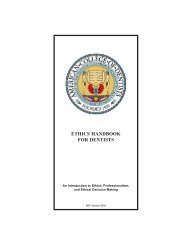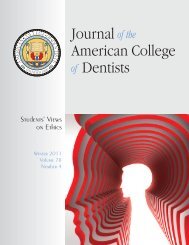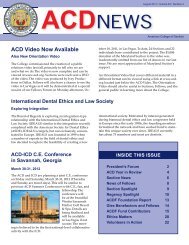JACD 71-4 - American College of Dentists
JACD 71-4 - American College of Dentists
JACD 71-4 - American College of Dentists
- No tags were found...
Create successful ePaper yourself
Turn your PDF publications into a flip-book with our unique Google optimized e-Paper software.
The Work to Be Done<br />
With all this good news, what are tomorrow’s<br />
leaders going to have to work on?<br />
Let’s start with access to care,<br />
especially for the underserved and needy.<br />
We have a good start on improving<br />
access to care with programs like Give<br />
Kids A Smile and others. We’re proud <strong>of</strong><br />
Give Kids A Smile, and what makes us<br />
especially proud is the fact that this<br />
program is really nothing new: taking<br />
care <strong>of</strong> vulnerable people on a charitable<br />
basis is something dentists have always<br />
quietly and faithfully done. In fact, we<br />
have a survey that shows that dentists<br />
give away in charitable free care<br />
annually an amount equal to about<br />
two-thirds <strong>of</strong> all the dentistry that is<br />
purchased by government.<br />
And there is a critically important<br />
message that Give Kids A Smile helps us<br />
to get across. The million-plus kids who<br />
are taken care <strong>of</strong> during this one-day<br />
event represent only the tip <strong>of</strong> the iceberg.<br />
Unmet needs continue every day in<br />
millions <strong>of</strong> other kids, and dentists alone<br />
and charity alone cannot solve the<br />
problem. Charity is at best a band-aid. It<br />
is not a delivery system. We have to find<br />
a larger and lasting way, through public<br />
policy, to make certain that every child<br />
gets an early start on a lifetime <strong>of</strong> oral<br />
health and that no child is unable to<br />
smile, unable to have confidence and<br />
make friends, or unable to study and<br />
learn and prepare for a successful future<br />
because <strong>of</strong> untreated dental disease.<br />
As we move forward with our discussions<br />
on access to care issues, it could<br />
well intertwine licensure, manpower,<br />
education, and government.<br />
Next, let’s turn our attention to the<br />
challenges that face our system <strong>of</strong> dental<br />
education. These challenges tend to boil<br />
down to available resources: money and<br />
people. Dental school enrollments continue<br />
to trend upwards. In 2003, there<br />
were 4,618 first-year enrollees, compared<br />
to 3,979 in 1990. Of course, that is below<br />
Journal <strong>of</strong> the <strong>American</strong> <strong>College</strong> <strong>of</strong> <strong>Dentists</strong><br />
the maximal years, when virtually every<br />
school accepted federal capitation grants<br />
to increase class sizes. The applicant<br />
pool remains very strong, with about<br />
7,900 applicants in 2003 for those 4,618<br />
slots. Each applicant typically applies to<br />
seven or eight schools. DAT scores and<br />
GPAs continue to increase.<br />
All <strong>of</strong> us surely acknowledge that<br />
the very value, effectiveness, and integrity<br />
<strong>of</strong> our pr<strong>of</strong>ession rest upon the twin<br />
foundations <strong>of</strong> dental research and<br />
dental education.<br />
But there is a problem and we need<br />
to acknowledge that our system <strong>of</strong><br />
dental education on the whole has been<br />
getting into deeper financial difficulties<br />
with every passing year and is now<br />
approaching a severe situation. For<br />
schools, the costs <strong>of</strong> providing dental<br />
education is skyrocketing at a time when<br />
we see a corresponding drop in federal<br />
and state support for dental education.<br />
Another unacceptable current situation<br />
is the number <strong>of</strong> unfilled faculty<br />
vacancies in our dental schools. A dental<br />
school vacancy amounts to a hole in the<br />
delivery <strong>of</strong> knowledge and skills to<br />
tomorrow’s practitioners. The latest data<br />
show that there are 307 vacant budgeted<br />
faculty positions in America’s dental<br />
schools, and 280 <strong>of</strong> those are full-time<br />
positions. The most common reason for<br />
a vacancy used to be retirement, but now<br />
dentists are leaving teaching to enter<br />
private practice.<br />
We have to see to it that those positions<br />
are filled, that dental education remains<br />
strong, and that our schools get some<br />
help with those skyrocketing costs. All<br />
<strong>of</strong> us have to make a commitment to<br />
dental education—-for the sake <strong>of</strong> our<br />
pr<strong>of</strong>ession and the public we serve.<br />
One <strong>of</strong> the most promising developments<br />
is the National Campaign for<br />
Dental Education that I mentioned<br />
earlier. The campaign will be part <strong>of</strong> the<br />
National Leadership Symposium<br />
ADA Foundation, which is now headed<br />
by Art Dugoni. I tell you, I called and<br />
called and called Art to come help us do<br />
this. I visited him at Pacific one day, and<br />
I unleashed everyone else I thought<br />
could influence him to come to our<br />
Foundation to help make his vision our<br />
pr<strong>of</strong>ession’s reality. And thank God, for<br />
he said yes to our call.<br />
Our mistake was that we didn’t ask<br />
him to do it ten years ago, when he first<br />
signaled the problem.<br />
The campaign is designed to<br />
complement and support other dental<br />
education fundraising efforts. Through<br />
a pr<strong>of</strong>ession-wide collaborative effort<br />
with our coalition partners, we plan to<br />
benefit the public’s oral health through<br />
a number <strong>of</strong> initiatives such as providing<br />
dental schools and students with funds<br />
for academic development, endowing<br />
faculty positions, and student scholarships.<br />
Specific areas we will address<br />
include faculty development, recruitment,<br />
and retention; facility improvements;<br />
innovative models <strong>of</strong> education; and<br />
programs to enhance diversity in<br />
the pr<strong>of</strong>ession.<br />
We have established a twelve-year<br />
goal to raise collectively $250 million as<br />
part <strong>of</strong> a larger twenty-five to thirty-year<br />
goal <strong>of</strong> a billion-dollar campaign. Yes,<br />
you heard that correctly, and I know<br />
what you’re thinking: Dugoni has lost his<br />
mind and he’s taking Bramson along,<br />
too. But we’re talking about a huge<br />
challenge, and we need a huge resolve.<br />
There must be commitment in dentistry’s<br />
leaders, and this commitment must<br />
spread throughout the pr<strong>of</strong>ession.<br />
We will also be looking outside the<br />
pr<strong>of</strong>ession to the dental industry, the<br />
corporate sector, other foundations, and<br />
the government for support; but if we as<br />
dentists don’t believe in and support it,<br />
43





